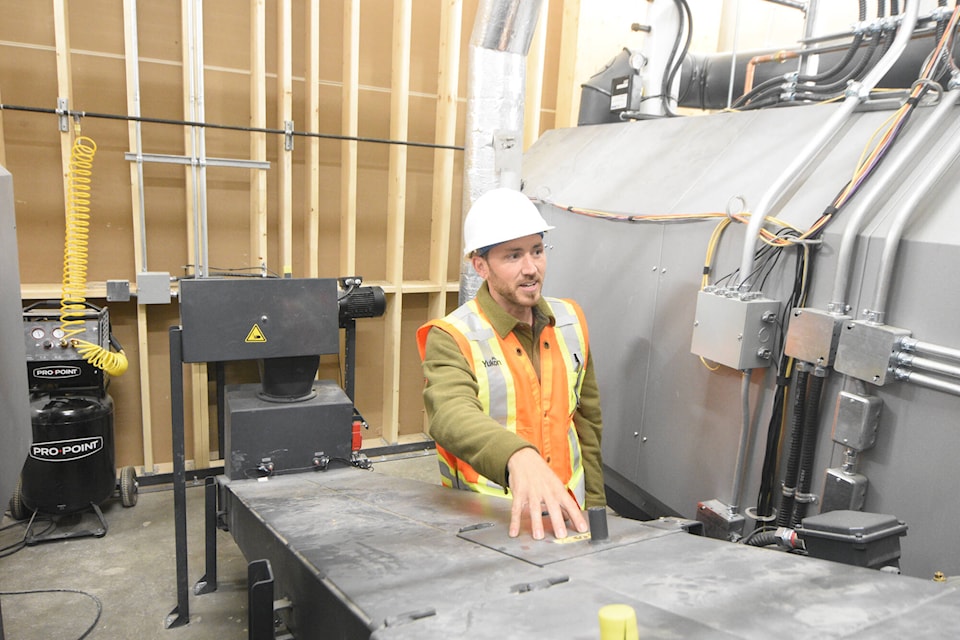By the time the cold weather returns in the fall, one of Whitehorse’s elementary schools will be warding off the chill with a system using both propane and wood chips or pellets. The biomass boiler that has been installed and tested in an outbuilding near Elijah Smith Elementary School is set to significantly reduce the emissions generated by heating the school.
On May 24, the territorial government unveiled the biomass system, built into an existing utility building at a cost of $2.3 million. Budget Plumbing and Heating was awarded the contract for the work in the fall of 2021 and will operate and maintain the system.
Territorial government project manager Jonathan Osborne said the biomass system, running off wood pellets or chips, will offset a minimum of 35 per cent of the propane that was previously used but said it’s expected it will provide a much larger proportion of the heat the school requires.
“Our government is committed to reducing our carbon footprint to projects like the Elijah Smith Elementary School biomass system. We are taking concrete action to achieve our emissions reductions, for using systems like biomass reduces our need for non-renewable heating fuels and, in turn, allows us to shape a clean, green and sustainable future for our territory,” said Environment Minister Nils Clarke prior to a tour of the facility for government employees and members of the local media.
Although the wood-fired boiler won’t eliminate the school’s use of propane completely, figures provided by the government suggest it will reduce greenhouse gas emissions by 180 tonnes per year, a similar amount of emissions to that released by burning 65,000 litres of heating oil.
Clarke said this is the equivalent of 800 round trips between Whitehorse and Dawson in a light-duty vehicle.
Along with the reduction of carbon footprint, the Yukon government representatives said the pivot to biomass energy opens the possibility of maximizing fuel input from local industry rather than relying on fossil fuels trucked to Whitehorse.
Although local fuel sources were noted as a goal for the future, the heating will initially rely on wood pellets from northern B.C. Osborne said the government is confident that it will be able to secure local fuel and that standing dead timber is the ideal source. He described the harvest of this standing dead wood for chips to feed biomass boilers as a “wide open” industry in the territory.
Osborne acknowledged potential conflicts between the cutting of standing dead trees to be chipped for biomass boilers and the home firewood supply, which has seen rising prices and periodic shortages in recent years, but he thinks the increased demand for the wood will allow the Yukon timber harvest industry to grow.
The development of the biomass boiler system for Elijah Smith Elementary School included research into similar systems across Canada. Osborne said it is the first one he is aware of that was specifically designed to accept both pellets and wood chips. While leading a tour of the new boilers, he explained that while both fuel types can be used, they cannot be mixed, and a minor modification to the feed system must be made to switch between them. A full load of the system’s hopper can keep the biomass boiler doing its part to heat the school through three weeks of -40 C temperatures.
The biomass system at the elementary school isn’t the first to be up and running in the Yukon. There are already operational systems in Dawson City and at the Whitehorse Correctional Centre. Osborne said that the government is in the process of awarding a design contract for another district heating system in Haines Junction.
“This isn’t our first kick at the cat, but it’s the most advanced that we have,” Osborne said.
On the tour, he explained some northern-devised design tweaks, including small hatches that allow for easier clearing of obstructions in the fuel feed system and a thermal buffer tank designed to maximize heating efficiency based on lessons learned from the boiler system at the hospital in Inuvik.
Note: An earlier version of this story stated that Minister Clarke said the boiler would reduce greenhouse gas emissions by the equivalent of 100 round trips between Whitehorse and Dawson per year. The story has been revised to reflect the correct figure of 800 round trips between Whitehorse and Dawson per year.
Contact Jim Elliot at jim.elliot@yukon-news.com
